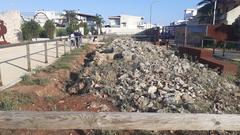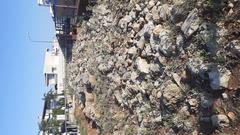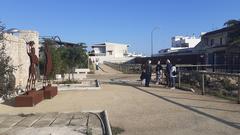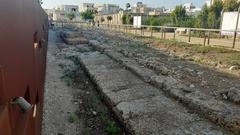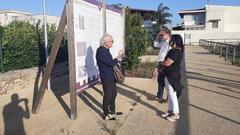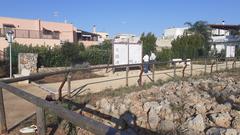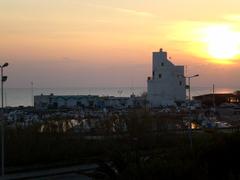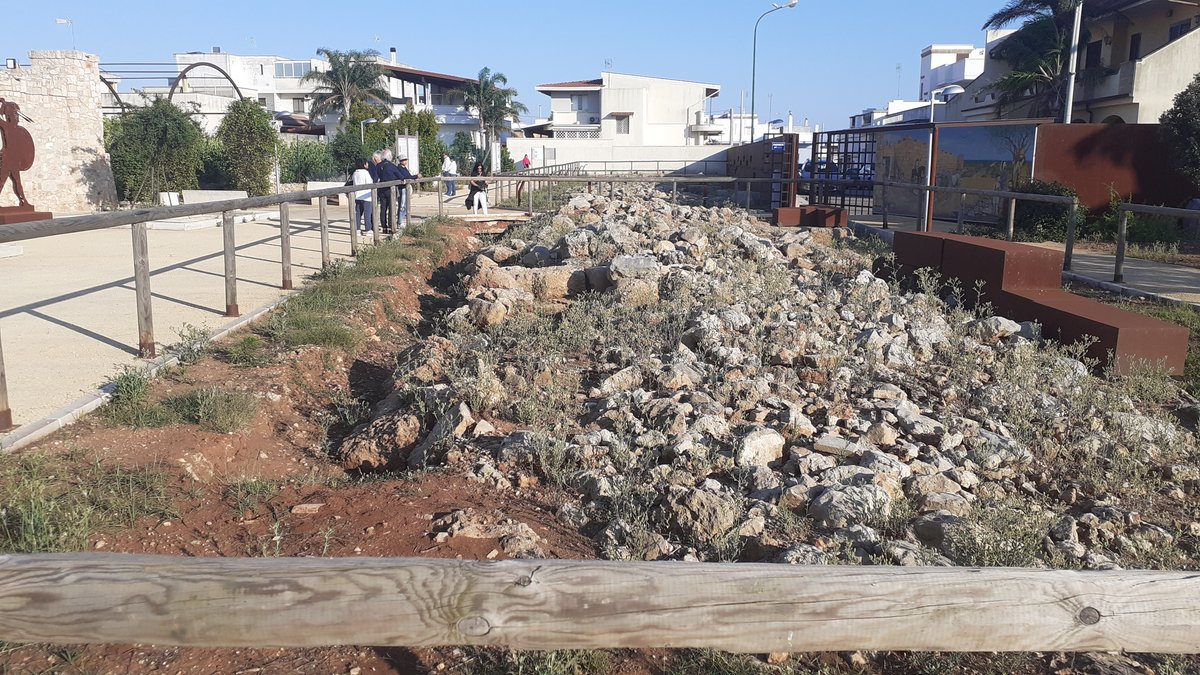
Messapic Walls of Ugento: Visiting Hours, Tickets, and Historical Significance
Date: 14/06/2025
Introduction
Nestled in the heart of the Salento peninsula in southern Italy, the Messapic Walls of Ugento are among the most impressive remnants of the ancient Messapian civilization. These imposing limestone fortifications, dating from the 6th to 4th centuries BCE, provide an unparalleled window into a pre-Roman world defined by advanced urban planning, robust defensive architecture, and vibrant cultural exchange. Ugento (ancient Uzentum or Ozan) emerged as a significant Messapian city, renowned for its strategic coastal position, economic autonomy, and dynamic interactions with Greek and Illyrian peoples (The Archaeologist; Wikipedia: Messapians).
Today, the Messapic Walls are seamlessly integrated into Ugento’s historic center, offering visitors a unique opportunity to traverse ancient streets, explore nearby museums, and immerse themselves in the region’s rich heritage. This guide provides essential information for planning your visit, including historical context, practical details on visiting hours and tickets, accessibility, guided tours, tips for exploring Ugento, and insights into the broader Messapian legacy.
Contents
- Introduction
- Historical Background
- Origins and Construction
- Messapian Civilization and the Role of the Walls
- Archaeological Context
- Discoveries, Inscriptions, and Urban Layout
- Preservation and Museum Collections
- Visiting Information
- Hours, Tickets, Accessibility
- Guided Tours and Educational Programs
- Practical Visitor Tips
- Cultural Context and Local Insights
- Nearby Attractions
- Accommodation and Amenities
- Language and Communication
- FAQ
- Conclusion and Call to Action
Historical Background
Origins and Construction
The Messapic Walls are a defining feature of Ugento’s ancient landscape, reflecting the engineering prowess of the Messapians, who settled in Apulia between the 8th and 6th centuries BCE (The Archaeologist). Ugento became a prominent Messapian center, with evidence of prehistoric settlement dating back to 1500–1000 BCE through menhirs and dolmens (Corte del Salento).
Built from massive limestone blocks using the polygonal masonry technique—without mortar—the walls once formed triple defensive rings with integrated towers and gates, such as the Porta di San Giuseppe (Manduria da Mare). Recent geophysical and electromagnetic surveys have mapped the walls’ extensive reach beneath modern Ugento, revealing their orientation, depth, and alignment (IMEKO MetroArchaeo 2023; Academia.edu).
Messapian Civilization and the Role of the Walls
The Messapians, believed to have migrated from the Balkans or eastern Mediterranean, were distinguished by their independence, sophisticated road systems, and agricultural expertise (ItaloAmericano). Ugento’s prosperity was marked by its own port, coin minting, and trade with Greeks, especially in wheat. The walls not only provided military defense—crucial during conflicts like the Punic Wars—but also delineated sacred, civic, and necropolis areas, shaping the urban and social order (Wikipedia: Messapians; Summer in Italy).
Archaeological Context
Discoveries, Inscriptions, and Urban Layout
Archaeological excavations have uncovered Messapian pottery, bronze artifacts, and over 600 inscriptions written in the Messapic language, using a script derived from Greek (Mnamon). These inscriptions, spanning the 6th to 2nd centuries BCE, illuminate religious beliefs, funerary practices, and community structure. The city’s urban plan included a central acropolis, residential quarters, sanctuaries, and necropoleis, all organized by the defensive walls (Summer in Italy).
Preservation and Museum Collections
Despite modern development, significant wall segments remain visible and have been preserved through ongoing archaeological and geophysical research (IMEKO MetroArchaeo 2023). The Museo Civico and Museo di Civiltà Messapica house treasures such as the celebrated bronze Zeus of Ugento, ceramics, and inscriptions (bblegemelle.it; Summer in Italy).
Visiting Information
Hours and Tickets
- Messapic Walls: As open-air monuments integrated into the town, the walls are accessible year-round, at all hours, and free of charge.
- Museo Civico di Archeologia e Paleontologia Salvatore Zecca:
- Open Tuesday–Sunday, 9:00 AM–1:00 PM and 4:00 PM–7:00 PM
- Tickets: ~€5 for adults; discounts for students/seniors (Audiala: Ugento Guide)
- Museo di Civiltà Messapica:
- Open Tuesday–Sunday, 9:00 AM–7:00 PM
- Tickets: €5 adults, €3 seniors/students, free under 12 (bblegemelle.it)
- Tickets can be purchased onsite at Castello di Ugento or online.
Accessibility
The main wall sections are in the historic center, easily reached on foot. Cobblestone streets and some uneven surfaces may challenge visitors with limited mobility; contact local tourist offices for accessibility details. Parking is available nearby.
Guided Tours and Educational Programs
Guided tours, available in Italian and English, can be booked through local operators and museums. These tours provide historical context and access to restricted areas. Educational programs are offered for schools and families, especially during cultural events (Audiala: Ugento Guide).
Practical Visitor Tips
- Best Time to Visit: Late spring and early autumn (May–June, September–October) are ideal for pleasant weather and fewer crowds.
- What to Bring: Comfortable shoes, sun protection, water, and a camera. Modest clothing is suggested if visiting religious sites.
- Safety/Etiquette: Do not climb on the walls or remove stones. Follow posted guidelines and remain on marked paths.
Cultural Context and Local Insights
Ugento’s Messapic heritage is celebrated through festivals, museum exhibitions, and community events. The annual Festival of Madonna dell’Aiuto, archaeological walks, and culinary fairs all reflect a vibrant connection to the past (Audiala: Ugento Guide). Local artisans and markets offer Messapian-inspired crafts, olive oil, and wine.
Nearby Attractions
- Castello di Ugento: Medieval castle and cultural venue
- Necropoli Messapica: Ancient burial grounds
- Cattedrale di Santa Maria Assunta: Romanesque cathedral on ancient foundations
- Marine di Ugento: Beautiful Ionian beaches and Torre San Giovanni
- Rural countryside: Olive groves and masserie for agritourism
- Other Messapic cities: Day trips to Manduria, Oria, and Lecce (Wikipedia: Messapic language)
Accommodation and Amenities
Ugento offers hotels, B&Bs, and apartments near the historic center. Dining options feature regional cuisine and “Messapic menus.” Parking, restrooms, cafés, and shops are available nearby (Booking.com: Messapica Rooms; Audiala: Ugento Guide).
Language and Communication
Italian is the primary language; English is spoken in tourist venues. Learning a few Italian phrases is appreciated and enhances your visit (Audiala: Ugento Guide).
Frequently Asked Questions (FAQ)
Q: What are the Messapic Walls visiting hours?
A: The walls are open-air and accessible at any time, year-round.
Q: Is there an entrance fee to visit the Messapic Walls?
A: No, visiting the walls is free. Museums charge a small fee.
Q: Are guided tours available in English?
A: Yes, guided tours in English and Italian are offered by museums and local operators.
Q: How can I reach Ugento?
A: The nearest airport is Brindisi (~100 km); from there, travel by train to Lecce, then by bus or taxi to Ugento.
Q: Is the site wheelchair accessible?
A: Some areas are challenging due to uneven terrain; contact tourist offices for accessible routes.
Conclusion and Call to Action
The Messapic Walls of Ugento are a monumental testament to ancient ingenuity and cultural richness. Their preservation within the modern town allows visitors to walk in the footsteps of the Messapians, explore nearby museums, and engage with living traditions. Plan your visit for late spring or early autumn, join guided tours for deeper insights, and support local preservation by respecting the site and embracing community events.
For the latest visitor information, guided tour options, and interactive resources, download the Audiala app. Follow us on social media for updates on events and discoveries. The Messapic Walls invite you to experience the enduring spirit of Ugento’s past and present.
Visuals:
Seek out high-quality images of the Messapic Walls, the Museo di Civiltà Messapica, and local festivals, using descriptive alt tags such as “Messapic Walls Ugento ancient fortifications” and “Ugento historical sites.” Consider including an interactive map or virtual tour for enhanced engagement.
Official Sources and Further Reading
- The Archaeologist: The Lost Civilization of the Messapians
- Corte del Salento: Ugento Città Messapica
- Manduria da Mare: Archaeological Park of the Messapian Walls
- IMEKO MetroArchaeo 2023: Electromagnetic Prospecting of the Messapic Walls
- ItaloAmericano: The Messapians
- Mnamon: Messapic Writing and Inscriptions
- Summer in Italy: Ugento Guide
- Wikipedia: Messapians
- bblegemelle.it: Ugento Città Messapica
- Audiala: Ugento Guide
